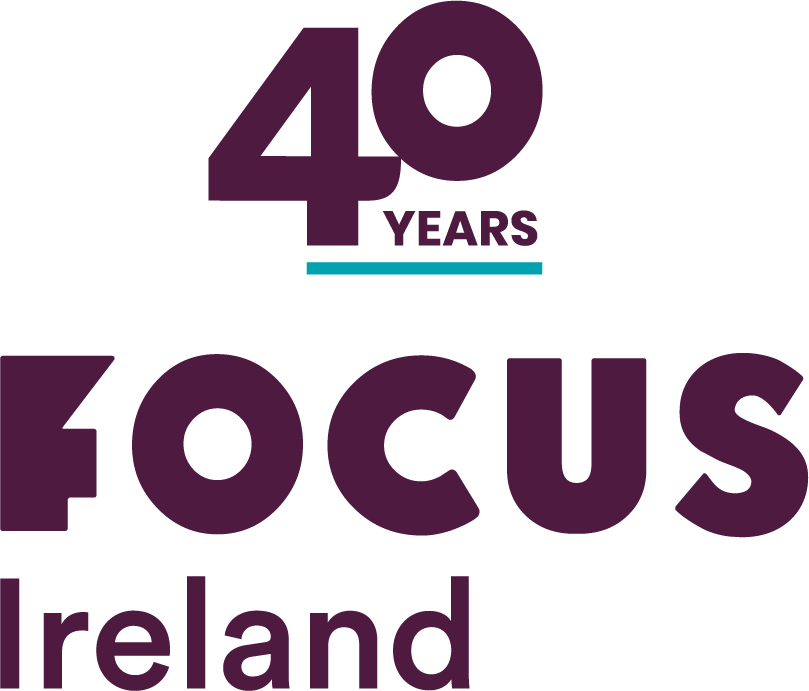Non stop increase in adult-only homelessness over last decade shows we need a serious rethink
Author: Emma Byrne
Over the last 3.5 years, there has been considerable and important discussion around fluctuations in family and child homelessness, with the number of children homeless falling to the lowest level in 5 years in mid-2021 before rising to a record level last month. Focus Ireland and others have rightly published a lot of material looking at families and children who are homeless, but because of the way that figures were published during most of this period, the pattern of homelessness among single people, or adults without accompanying children, has been much less visible. Our Focus on Homelessness series, which takes a closer look at the available data on homelessness in Ireland and analyses emerging trends, today publishes our latest edition examining trends in relation to adult-only homelessness since December 2020 (available here), following our previous edition on this topic (available here).
Our new report shows that adult-only homelessness has been allowed to steadily increase, year on year since 2014, we now have triple the number of homeless adult-only households than we did just a decade ago. As shown in Figure 1 below, this trend of an almost constant rise in the number of adults without accompanying children in emergency accommodation (EA) is divergent to the fluctuations in family and child homelessness we have witnessed. What is even more striking is that single persons’ homelessness has increased almost in a straight line for ten years: two changes in Government, five different Housing Ministers, the introduction and removal of many eviction bans, the collapse and recovery of housing construction, the launch of a successful, national Housing First programme.
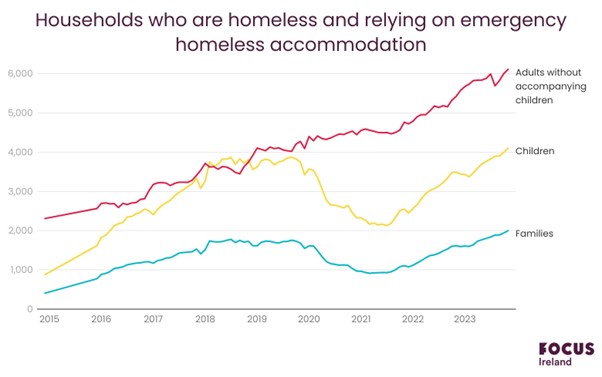
The number of adult-only households in Emergency Homeless Accommodation has tripled since 2014 (from 1,962 in June 2014 to 6,000 in October 2023). While the number of adult-only households is rising nationally, it is important to recognise that this rise was almost exclusively driven by trends in Dublin until the middle of 2022, as shown in Figure 3 in the report (and below). The number of adult-only households increased by 48% since the start of 2020 in Dublin, compared to 15% in the rest of the country. Dublin now accounts for over 70% of all adult-only households in EA. Outside of Dublin, the number of adult-only households in EA had plateaued since the start of 2019, remaining at approximately 1,500 each month in 2019, 2020 and 2021. Though, since the start of 2022, there has been a rise in the number of adult-only households in EA outside Dublin by 10%. However, as highlighted by previous Focus on Homelessness reports, this overall ‘Rest of Ireland’ trend does conceal considerable variation outside of Dublin when further broken down by region. Moreover, anecdotal evidence and reports from frontline services suggest that adults presenting as homeless in Dublin may travel to the capital due to lack of EA or services in other areas, however, current data does not allow us to confirm this hypothesis.
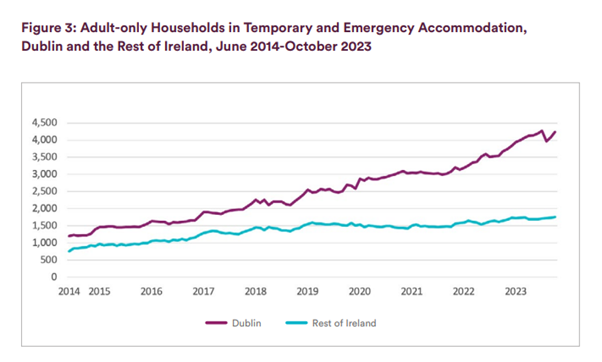
As well as trends in the where adult-only households are in EA, this report highlights specific gendered dimensions in homelessness, particularly in the last three years. Figure 8 in the report shows that the rise in adult-only households has been mainly due to an increase in the number of men in EA while the number of females in EA had plateaued in 2019, 2020 and 2021. Three-quarters of those in adult-only homeless households are now men. However, while the total number of males in EA is greater than the number of females, in the last three years, the number of female adult-only households in EA has risen at a faster rate compared to male households, there has been a 44% increase in the number of females compared to a 34% increase for males. This suggests that we need to be collecting data and designing policy that looks at the specific gendered dimensions that contribute to why men and women without accompanying children become and remain homeless.
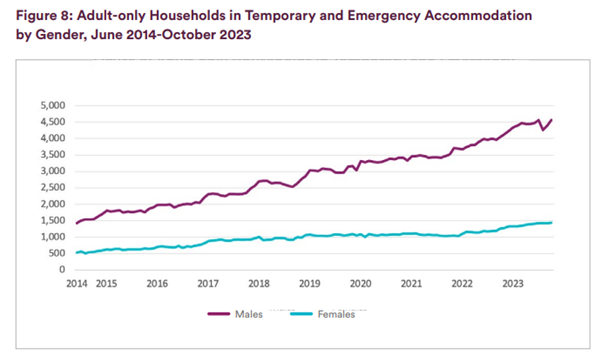
A particularly interesting graph in the report is the number of ‘acceptances’, that is the number of adult-only households that either enter EA or are diverted from entering EA. As presented in Figure 7 in the report, the number of adult-only households accepted as homeless in Dublin (national data not available) has been similar each year since 2018 (approx. 215 per month) apart from 2020 when there was a slight decrease. Despite the number of acceptances being very similar, the total number of adult-only households in EA as reported by the monthly homeless reports has increased by 62% during the same period. For example, in 2022 (the last full year of data) for every four adult-only households that entered EA in 2022, only one left. This would suggest that the continuous rise in the number of adult-only households in EA has not been caused by a large increase in demand for EA but rather that adult-only households are 1) spending longer in EA and 2) are finding it much more difficult to exit homelessness.
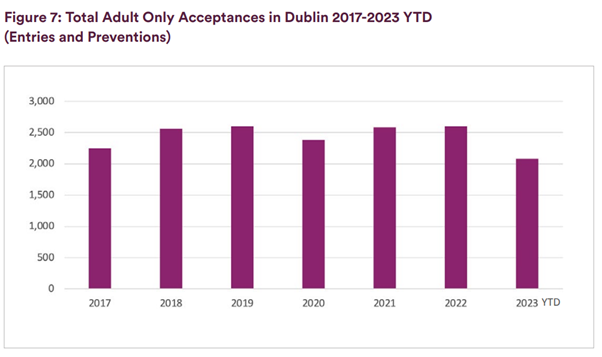
The private sector does not find it commercially viable to build homes for single person households and, although one adult households make up the majority of people on social housing waiting lists, homes suitable for their needs are only a fraction of social housing construction, there are no specific targets on how many 1-bed homes LAs should be building as part of their construction programmes. The number of one adult households assessed as qualifying for housing supports (sometimes referred to as Social Housing Waiting list) are significantly overrepresented on our waiting lists with one-person households only making up 23% of all households nationally according to Census 2022, but made up 56% of the households assessed that year who qualify for housing supports.
Ireland has committed to working towards ending homelessness by 2030 under the Lisbon Declaration. Our new report clearly shows that how we are approaching adult-only homelessness is wrong and without urgently addressing this issue we will not make progress towards our 2030 goal. We have clear evidence that we need to radically rethink the way we are approaching adult-only homelessness, including how we treat the needs of these households right throughout our housing system.

